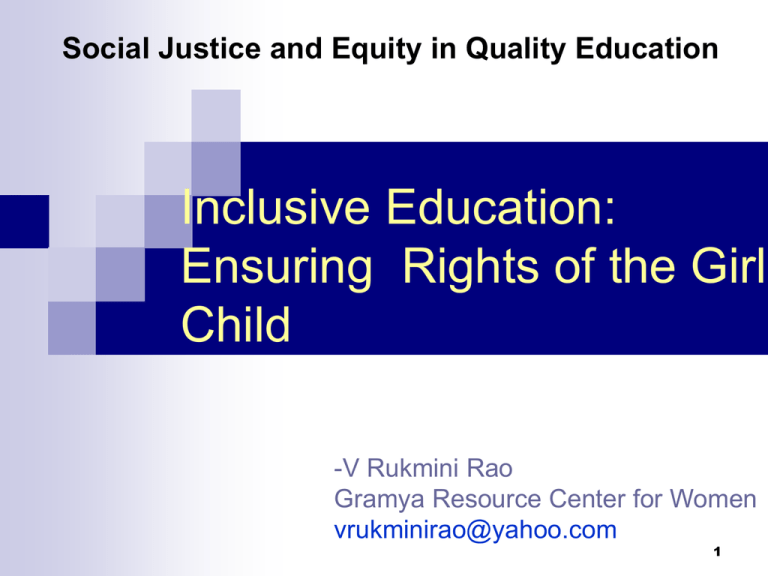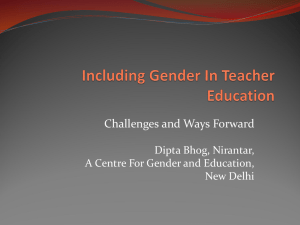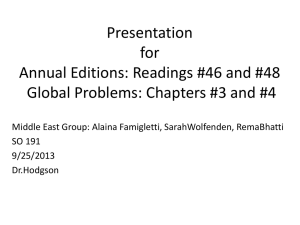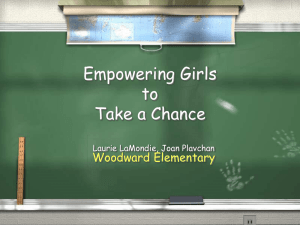
Social Justice and Equity in Quality Education
Inclusive Education:
Ensuring Rights of the Girl
Child
-V Rukmini Rao
Gramya Resource Center for Women
vrukminirao@yahoo.com
1
The Current Status-Gender
Discrimination
World-wide of the more than 110 million children
not enrolled in school, nearly 60% are girls
By age 18, girls have received an average of 4.4
years less education than boys
In some countries in sub-Saharan Africa,
adolescent girls have HIV rates up to five times
higher than adolescent boys
Pregnancies and child-birth related health
problems cause the death of nearly 146,000
teenage girls each year
2
The Current Status-Gender
Discrimination-contd..
In sub-Saharan Africa, a woman faces a 1 in 13
chance of dying in child birth
At least one in three girls and women worldwide
have been beaten or sexually abused in their life
time
An estimated 150 million girls under 18 have
experienced forced sexual intercourse or other
forms of sexual violence involving physical
contact.
Three million girls and women are subjected to
female genital mutilation every year
3
The Current Status-Gender
Discrimination-contd..
Over 100 million women are now missing
in Asia which will result in a 12 to 15%
excess of young men in the next 20 years
China and India alone are responsible for
80 million missing females.
Women and children account for 80% of
civilian casualties during armed conflict
Source: Vital Statistics UN Cyber School Bus, UN Secretary General’s
Study on Violence against Children, UNICEF
4
Girls’ Education in India
At the time of independence, the national
female literacy rate was as low as 8.9%
Gross enrollment ratio for girls was 24.8%
at primary level and 4.6% at the upper
primary level in the 11-14 years age group
5
Access to Schooling Improved
In 1950-51, 2,09,671 primary and 13,596
upper primary schools were functional
In 2004-05, 7,67,522 schools are
functional at the primary level and
2,74,731 schools at the upper primary
level.
Today 98% of India’s rural population has
access to primary schools within a
Kilometer of their habitation
6
Access to Schooling Improved
In 1950-51, enrollment of boys was 13.8
million and 5.4 million girls in primary
school.
In 2004-05, this has increased to 69.7
million boys and 61.1 million girls in
primary school
At upper primary level, enrollment
increased from 2.6 million boys and 0.5
million girls to 28.5 million boys and 22.7,
million girls
7
Policy Framework
Constitution of India Article 15(1): Prohibition of
discrimination on grounds of religion, race,
caste, sex or place of birth.—(1) The State
shall not discriminate against any citizen on
grounds only of religion, race, caste, sex, place
of birth or any of them.
Education for All, 1986
Modified in 1992
Sarva Shiksha Abhiyan, EFA 2001
8
Policy Framework –Contd..
Earlier education was a State subject in
the federal structure
42nd Constitutional Amendment in 1976
brought education into the concurrent list
Education now responsibility of Central
government, State Government, Local
Government
Education cess levied to raise resources
9
Policy Framework –Contd..
86th Constitutional Amendment Act, 2002
has made elementary education a
fundamental right for children in the age
group of 6-14 years by providing that “the
state shall provide free and compulsory
education to all children of the age of six to
fourteen years in such manner as the
State may, by law, determine”
10
Role of International Agencies
UNICEF- Research, Reports and public debate
ILO- Campaign to prevent child labor, NCLP,
financial support
SIDA
The Government of Netherlands
DFID- Quality of education, Support in AP
World Bank- DPEP Support
Civil Society Organizations – International
campaigns
11
Stop Child Labor Campaign
Campaign carried out by Alliance 2015, Network of
European Development Organizations
Action plan for companies to combat child labor
Focus on all forms of child labor (not only worst forms)
Engagement with companies in the global supply chain
Combating child labor within broader goals of realizing
labor rights
Focus on engagement with multi stake holders including
unions, NGOs and governments
12
To Promote Inclusive Education,
Indian Experience
Required change in attitude of the elite
Early understanding that poverty had to be
overcome to ensure universal education
Child labor was a necessary evil for
survival
Cannot interfere in family life and bring
girls into public life
Fear for safety of girls
Lack of resource allocation
13
Some Significant Barriers- to
Ensure Inclusive Education
Extreme poverty
18 official languages
29 languages spoken by more than one million
people
More than 2000 dialects
High levels of child labor
Girl children invisible due to bondage at home
Remote location of villages/hamlets
14
Role of Civil Society in India
Making a shift from focus on access to creating
demand
Anti
child labor campaigns
Identifying “missing” girls
Community mobilization
Mobilization of SHGs
Mobilization of local leaders
Mobilization of religious leaders
Mobilization of Children/girls
Mobilizing through street plays, public meetings,
workshop seminars
15
Role of Civil Society in IndiaContd..
Local state and national networks formed
Public debate and lobbying with parliamentarians
Women’s movement demand for 6% of the budget
for education, 1995 Beijing conference outcome
Vertical mobilization from the grassroots to
international organizations
Millennium Development Goals, Wada Na Todo
Campaign
Mid day meal programme in schools (Right to
Food)
16
Strategy
Adult Literacy programmes (failed but created
demand for primary school’s for disadvantaged
children)
Night schools for children
Part time day schools
Summer camps (30 to 45 days) to enroll children
in hostels
Back to school programme with residential
bridge schools
Demand for government hostels, target SC/ST
boys and girls
17
Creating Access
Demand for minimum infrastructure
School
building
Close location of early childhood education centers in
primary schools (brought girls into school)
Toilets
Drinking water
Residential schools for vulnerable children
Demand for Teachers
Teacher
Training
Quality learning material
Constant monitoring
18
Gramya Experience with Lambada
Community
Campaign to stop female infanticide and sale of girl
babies for international adoption through community
mobilization
Successful advocacy and lobby with state government
Identification of out of school children including girls
Demand for local schools from the state government
Interim schools started with support from CRY handed
over to state government
Setting up bridge-school for girls (on going)
Link to welfare hostels
Need for continuous support to girls and counseling of
family members
Up scaling in collaboration with state government,
SERP Programme
19
Gramya Experience
Integrated approach
Prevent violence against women
Identify vulnerable families with a large
number of girls
Identify all out of school girls and send
them back to school, bridge-schools,
government hostels
Stop female infanticide
Prevent girl child marriage
20
Gramya Experience Contd..
Prevent child labor
Identify vulnerable teenagers and send
them back to school
Prevent trafficking of girls and women
Rights training for adolescent girls
Responsibility with women leaders of
SHGs
Vertically integrated from the village to the
district level
Supervision of school facilities by SHG
leaders (in the process of being set up)
21
Vulnerability of Dalit Children/Girls
Practice of untouchability
Girls made to clean playground
Made to sit at the back of the class
Discrimination by teachers
Poor quality of food served
Poor infrastructure facilities
Sexual harassment of girls
Alcoholic teachers
Response-campaigns to prevent discrimination
School committee set up with responsibility to
community leaders
22
Who remains out of school?
Girls from extremely poor families/suffering ill
health
Orphan girls
From shepherd community
Migrating parents
Girls from large families where household help is
required
Older girls who missed primary school
Girls from tribal community (others) living in
remote hamlets
23
Who remains out of school?
Girls from violent homes
Girls with disabilities
Children of sex workers
Agriculture child labor (picking cotton,
helping the families etc)
Girls from Muslim Community (some may
be enrolled in religious schools)
24
Quality of Education Issues
Relevance
Achieving minimum levels of Learning
Assessment through standardized achievements
tests
Need to improve achievement, testing
methodology
Need for curriculum reforms
Restructuring teacher training contents and
methodology
25
Quality of Education Issues Contd..
Poor infrastructure
Overcrowded class rooms
Lack of competency based teaching
learning materials
Poor science teaching
Poor mathematics teaching
Poor language teaching
26
Quality of Education Issues Contd..
Poor supervision in educational
administration
Unqualified teachers
Limited/nil in service training
Achievement levels tend to decline as the
children move up in the educational
hierarchy
27








